And the nest was active.
I’ve been photographing birds (or attempting to) from the same spot near a creek for several years with varying success but yesterday morning I had an unexpected opportunity with a subject completely new to me – a Yellow Warbler nest.
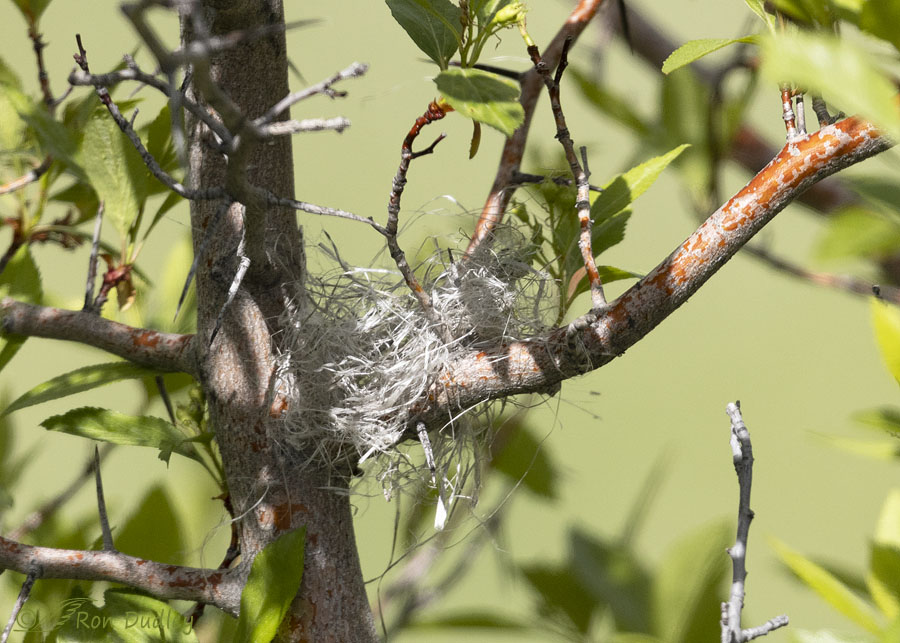
When a female Yellow Warbler flew into this hawthorn bush it soon became apparent that she had a nest in there. The first time she flew in I was having trouble with one of the “quirks” of the mirrorless Canon R5 that I’ve alluded to in the past so I was unable to photograph her on or near the nest. Yes, I was cussing a blue streak.
This photo was taken after she left.
The nest itself looked different to me than my mind’s eye anticipated from a warbler’s nest. The construction materials, whatever they are, are more consistently the same than I expected them to be and they’re very lightly colored – almost white. I’m still trying to figure out precisely what they are. Maybe old, sun-bleached grass blades?
Cornell’s Birds of the World says that Yellow Warbler nests typically have three layers – a base, a frame and a liner. In one location the base consisted mostly of nettles and the frame consisted mostly of grass fibers. What we’re seeing here could be the frame or the liner – my guess is the frame. Cornell goes on to say this about the liners of Yellow Warbler nests analyzed in that same area:
“liner composed mainly of deer hair, feathers, and fibers of airborne seeds (mostly cottonwood, dandelion, willow, and cattail.) All listed materials found in all layers but proportions differ.”
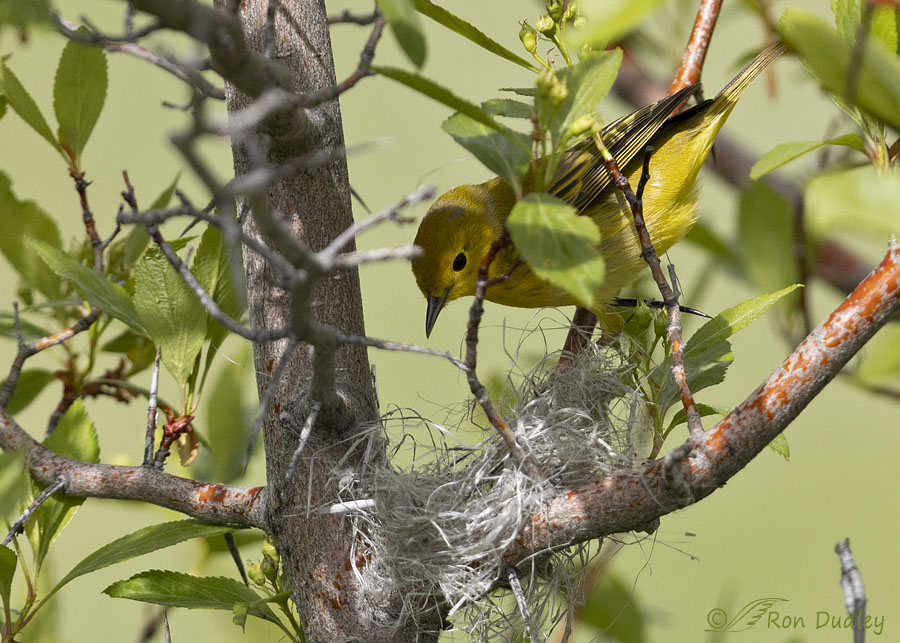
The next time she came back I’d conquered the R5’s quirk (temporarily at least) so I was able to get quite a few photos of her at the nest but the bright sun made the scene contrasty and full of shadows so I won’t include any more of those shots.
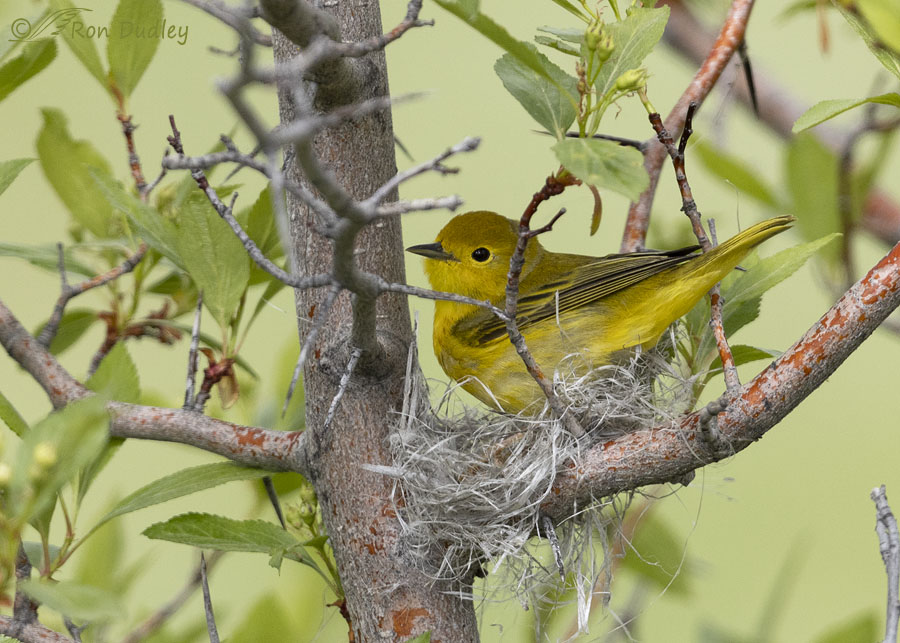
Thankfully, on her next visit to the nest, the sun was behind what I sometimes refer to as a “cloud from hell” so the annoying shadows mostly disappeared and the light became more appropriate for the situation. I prefer my photos of her in the shade over those taken in bright sunlight.
I suspect she brought nesting material in on these visits (“nests are built by females in about 4 days”) but if she did I never noticed any in her bill, probably because she usually entered the nest from the back of the bush.
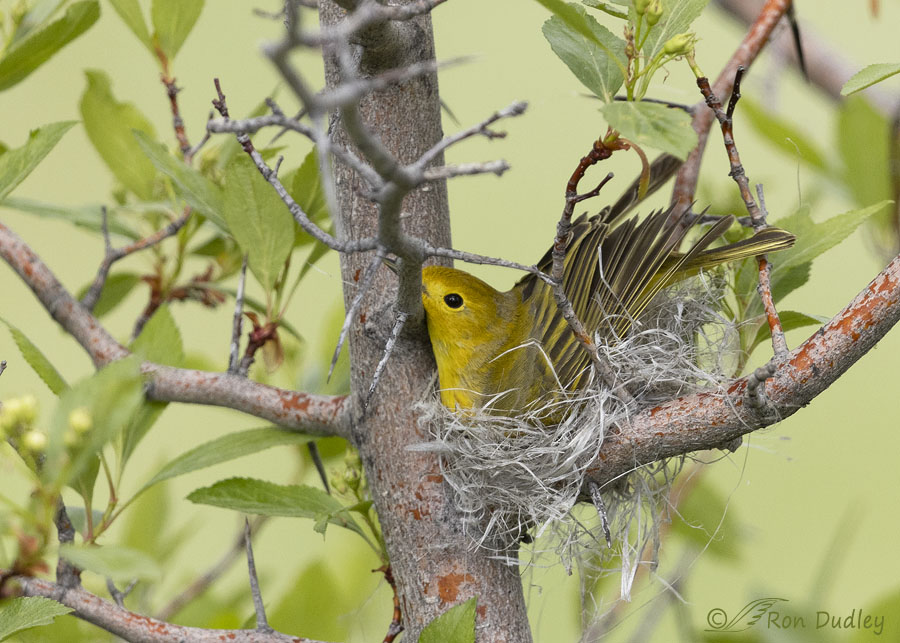
While on the nest she spent much of her time forming the nest cup, or what would become the nest cup, with her body.
Here she also appears to be checking out one of the twigs to see if it would be a comfortable and convenient place to rest her bill while she’s incubating but I doubt that’s really what she was doing. It’s probably just where her bill and ‘chin’ ended up temporarily while she was working on forming the nest shape.
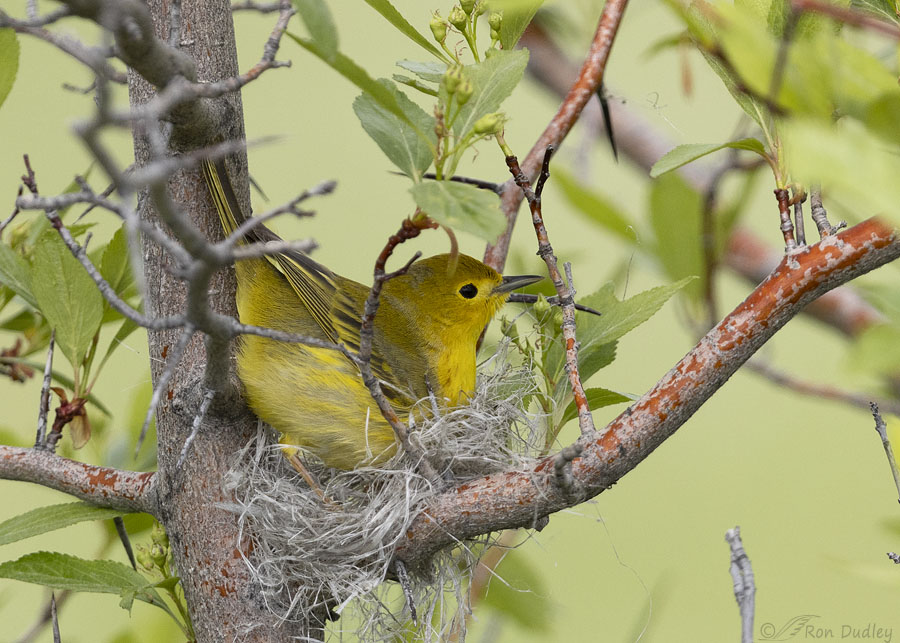
She squirmed and wriggled her cute little butt on the nest as she worked to make it comfortable for her. While in this position she lowered her head and used her bill to pull some of the nesting material toward her body but I’m not including those shots because my active focus point kept locking on to that twig in front of her bill so her face was never very sharp.
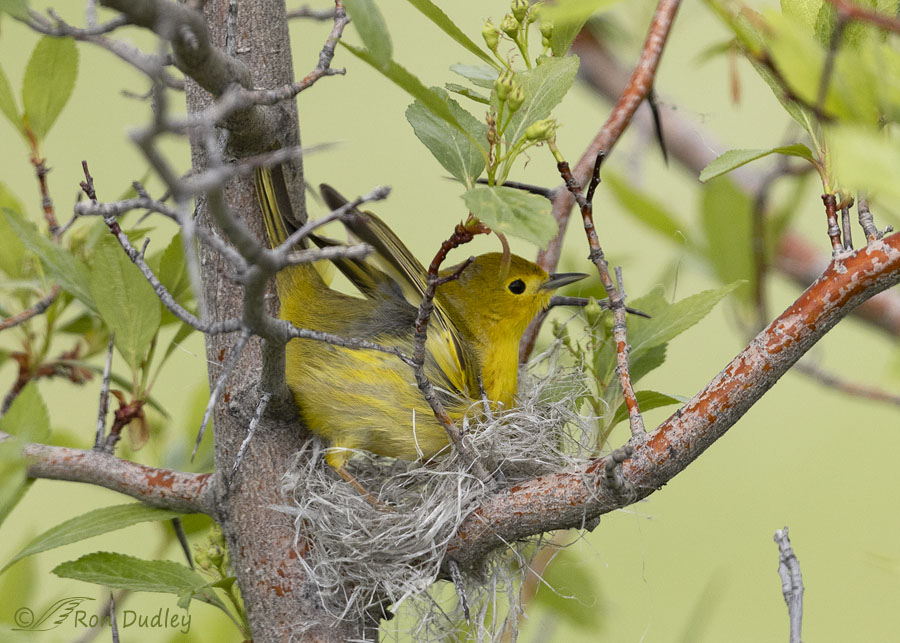
At times while she was wriggling on the nest her wings would flutter up which I thought made for some interesting behavioral poses. In this low light I was pleasantly surprised that I had enough shutter speed (1/1250 for this shot) to get her wings reasonably sharp.
In all these years of photographing Yellow Warblers I’d never photographed or even seen one of their nests until yesterday. Earlier that same morning at another location I knew exactly where another Yellow Warbler nest was but I couldn’t quite see it because at my precise shooting angle there were twigs and leaves between me and the nest.
Stuff like that happens when you’re not willing to risk moving your location or doing anything else that might disturb a nesting bird.
Ron
Notes:
I was shooting from inside my pickup, I never approached the nest and the warbler was definitely not disturbed. These photos are very large crops (17% of the original image or slightly smaller) that were taken with a super telephoto lens plus teleconverter.
Image techs for these photos were 1/1250 – 1/5000, f/5,6, ISO 800, Canon R5, Canon EF500mm f/4L IS II USM + 1.4 tc
I’m still hoping to publish a post on the “quirks” of the mirrorless Canon R5 sometime fairly soon but that post will be long and complex and with everything going on in my life at the moment I can’t promise when it will happen.


Sweet little bird. One of Spring favorites !! I hope that you will be able to continue watching and photographing this nest and look forward to seeing more !!
Oh, these photos are delightful! And charming! Love to see this beautiful warbler and her nest in this setting, so peaceful and serene. I hope Mama YW lays lots of eggs and successfully populates the earth (well, Utah) with lots of pretty babies.
Thank you, Chris. I hope so too.
How fascinating to be able to see the process (or some of it) towards making the nest safe (and comfortable) for her and her chicks. And what a tiny beauty she is…
I do hope that since she has building and incubating responsibilities her mate will take on the feeding role.
EC, the male only has partial responsibility for feeding the chicks. They both do it.
That figures…(and I assumed as much). I hope she keeps him busy though.
I have seen the males feed the females while incubating.
Beautiful series. I am interested in the quirks.
Your description and photos of the warbler wriggling around to form the cup remained me of our imprinted house sparrow Lucky. Lucky came to us imprinted as a sickly fledgling. She lived with us for 12 years with full flight access to the entire house. She was an amazing bird and we learned so much from her. One of her favorite things was to nestle down at the base of your neck under long hair and shirt collars. She would dig and scoot and rock back and forth making a comfortable spot on your neck. The scratching hurt but the rest tickled. She would stay and sleep for short times or sometimes in winter for and hour at a time. If you moved too much and disturbed her she would scold and sometimes pinch your neck.
Ha, that sounds like a sparrow with an attitude, April. I admire your devotion to birds. All birds.
What a great treat – for you and for us. A few times I have seen a Yellow Warbler fly into a bush with nest material and simply disappear. The nest was too well hidden to find but I knew it had to be there somewhere. The only nest I have had an opportunity. to examine closely was in a collection of nests. The tag on the nest was torn so the last digit of the date was partially missing. There was enough information to know that the date was either 1916 or 1918. It was interesting to see the structure but I much prefer your photos.
Dan, I had to be lucky with my timing to see this nest. A couple of days earlier and there wouldn’t have been even the beginnings of a nest and a few days later I’m sure the nest will be completely hidden by more and larger leaves.
The butt is cute!
Agreed.
Love this bird..a love seeing its nest👍👏👍
Good!
Perfectly captured “spring is in the air!’ She is beautifully yellow, the soft green background, the green leaves, and the contrasting color of the twigs and her nest – absolutely charming!!
Thank you, Kathleen.
Exceptional photos, Ron, especially the second: critiquing her work and calculating the next layer. I think we need a DNA analysis to determine what the nesting material is, although Sara’s ideas sound plausible.
Thanks, Lyle.
Those photos are amazing. She really looks like she’s enjoying her work! So far, to me, the nest looks like bunchgrass fibers. Sand dropseed and Indian ricegrass typically retain thatches of old leaves for years, which bleach out whitish, so it could be those if they are in the area.
Sarah, I don’t know my native (or even invasive) grasses very well so I’m not sure. Now if it was cheat grass, that would be another story… 🙂
Excellent photos Ron in spite of those twigs interfering with the focus. Yellow Warblers sure are pretty birds. That nesting material looks to be synthetic. Will be interesting to see all the comments to see if anyone has ever seen material like that.
Everett, it sure would be interesting to know what it is with confidence.
Maybe you could get the nest after she’s done with it to find out. I am intrigued.
Delightful, happy photos! So nice to see a warbler in her nest. Something I too have never seen and your pictures are the next best thing! Thanks.
Thank you, Joanne.
Beautiful and interesting photos. Love them. So glad the opportunity presented itself for you Ron.
Thanks very much, Mark.
We have a park with two small fishing lakes, but part of it is a wetlands for nesting birds. Come mid-April in this park, the yellow warblers are as numerous as house sparrows. I watch them dive in and out of honeysuckle and willows, but have never seen a nest. At least now I know what to look for. Thank you.
Connie, my guess is that their nests can look very different from each other depending on location, availability of suitable nesting materials and stage of construction.
She’s a lovely creature, and the red bark is an attractive color accent to her
buttery yellow feathers and the fresh green of the surrounding leaves– the
whole picture captures the essence of spring !
” the whole picture captures the essence of spring”
Well said, Kris.
Interesting! Wondered where they nested. Sure is a sloppy mess at this point unable to safely hold eggs – not at all what I would have expected. 😉 Luv those little birds……. 🙂
I agree, Judy. She’s probably got significantly more work to do before the nest will be a safe place for the eggs.